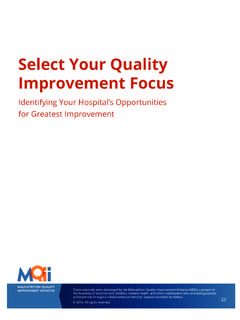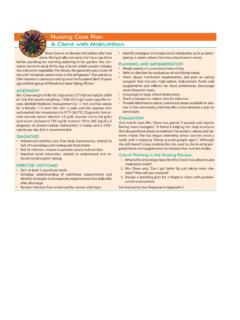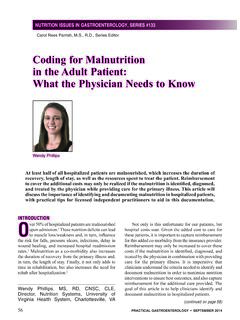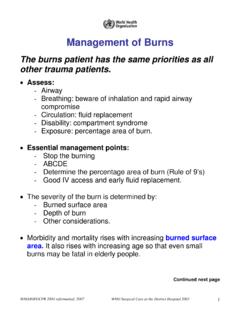Transcription of Principles and Models of Quality Improvement
1 TM. Principles and Models of Quality Improvement Healthcare Quality and Quality Improvement are terms that describe discrete, yet interrelated concepts. The Institute of Medicine (IOM) defines healthcare Quality as a direct correlation between the level of improved health services and the desired health outcomes of individuals and populations. 1 Whereas the definition of Quality Improvement places a focus on measuring change, consisting of systematic and continuous actions that lead to measureable Improvement in healthcare services and the health status of a targeted patient group. 1 Quality Improvement often seeks to raise the standards of care in alignment with IOM aims for Improvement in outcomes for individuals and To build a healthcare system that provides efficient, effective, and consistent care , it is important that healthcare organizations apply the Principles of Quality Improvement in all aspects of clinical care .
2 Following the passage of the Affordable care Act in 2010, stakeholders in the industry are striving to improve the value of care delivery and prevent costly negative patient outcomes through Quality Improvement initiatives that promote care efficiency, patient-centered care , provider coordination, and clinical best TM. These materials were developed by the malnutrition Quality Improvement Initiative (MQii), a project of the Academy of Nutrition and Dietetics, Avalere Health, and other stakeholders who provided guidance and expertise through a collaborative partnership. Support provided by Abbott. 1. TM. 1. 2016.
3 All rights reserved. The Health Resources and Services Administration (HRSA) notes that the Quality Improvement model includes four key Principles to support successful initiatives:1. Focus on delivery Focus on patients system and processes Quality Improvement Organizational resources e orts should address the and processes must be needs of the patient by addressed together to targeting patient access, impact outputs and safety, and promoting outcomes of Quality patient engagement Improvement e orts Focus on a Focus on the use team-based process of data Successful Quality Both quantitative and Improvement e orts qualitative data are usually incorporate a essential to assessing the team-based approach to success of Quality achieve long-term.
4 Improvement e orts and meaningful improvements providing guidance for initiative modi cation Figure 1: Key Principles to Support Successful Quality Improvement Initiatives A well-defined Quality Improvement program consists of systematic activities that are organized and implemented by an organization to monitor, assess, and improve its healthcare. 1 The goal of Quality Improvement programs is to seek continuous Improvement in the care delivered to the patients the organization Intrinsic to the successful implementation of a Quality Improvement initiative is the focus on the patient. Increasingly, evidence demonstrates the positive impact patient engagement has on improving patient outcomes and reducing the cost of care .
5 The National Quality Forum (NQF) defines patient- and family-centered care as an approach to the planning and delivery of care across settings and time that is centered on collaborative partnerships among individuals, their defined family, and providers of care . It supports health and well-being by being consistent with, respectful of, and responsive to an individual's priorities, goals, needs, and values. 3. 2. TM. The concept of patient-centered care is one that is evolving as the role of the patient becomes increasingly defined. In today's healthcare environment, stakeholders are looking beyond assessing the Quality of the patient experience and promoting activities that involve patients in their care as informed consumers.
6 Patient-centered care may include patient engagement, activation for self- care , and shared decision making around the determination of the appropriate course of treatment and disease management. Patient Experience Patient Engagement Patient Empowerment Patient-Centered care Figure 2: Aspects of Patient-Centered care In support of developing patient-centered Quality and clinical safety improvements, the nursing Alliance for Quality care released a list of nine core Principles designed to support nurses and healthcare providers in 2013 (see Figure 3).4 Hospitals and health systems that have been successful in promoting patient- centered care adopt Principles that are very similar to those released by the nursing Alliance for Quality care or develop their Following these Principles may help incorporate aspects of patient-centered care into your practices as you implement this Quality Improvement initiative.
7 3. TM. There must be an The patient is the care is based on active partnership source of health shared responsibilities among patients, their information and has and relationships families, and their right to make own among patient, family, healthcare providers care decisions and clinicians care must respect Families and friends of Patient rights include boundaries of privacy, the patient are mutuality: competent decision considered an information sharing, making, and ethical essential part of the consensus forming, behavior care Team and shared decision making Clinicians should Acknowledge and Healthcare literacy advocate for patients appreciate cultural, and linguistically - unable to fully racial, and ethnically appropriate participate in own diverse backgrounds interactions are care essential Figure 3: Principles of Patient-Centered care Figure 3.
8 Principles of Patient-Centered care Additionally, online tools and health literacy resources can provide education to improve patient understanding of treatment options, thereby increasing a patient's ability to engage in the shared decision-making process. The Institute for Healthcare Improvement (IHI) has developed a white paper reviewing best practices for providing positive patient and family experiences during hospital stays. This white paper identifies primary and secondary drivers for hospitals that are associated with exceptional patient and family experiences of inpatient care and provides case studies from high-performing hospitals to demonstrate application of theory.
9 Primary drivers include:6. Leadership: Governance and executive leadership demonstrate that hospital culture is focused on patient-and family-centered care Provider Engagement: Staff and providers are fully engaged Respectful Partnership: All care interactions are based on a respectful partnership that anticipates patient and family needs Reliable care : Hospital provides high- Quality , reliable care 24/7. Evidence-Based care : care Team consistently applies collaborative, evidence-based care 4. TM. Examples of online tools to support patient education and engagement include the Agency for Healthcare Research and Quality (AHRQ) strategies for implementing a patient-centered medical home delivery Additionally, decision-support resources for malnutrition care are also available for clinicians, such as recommendations from the Choosing Wisely Campaign for specific patient conditions ( , dementia).
10 8 Links to these resources are provided in the Additional Resources section of this MQii Toolkit found on p. 75-78. Quality Improvement Models There are several Quality Improvement Models and frameworks an organization can consider to promote success. One of the most widely used Models is the plan -Do-Study-Act (PDSA) Cycle, a systematic series of steps for gaining valuable learning and knowledge for the continual Improvement of a product, service, or process. It has been visually depicted using a four-step approach as indicated in Figure 4. plan : Identify an opportunity to improve and plan a change or test of how something works within one component of the clinical work ow, including establishing metrics/indicators to assess progress toward the goal Act plan Do: Carry out the plan for Improvement for the speci c component of the clinical work ow.








